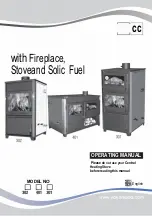
2 - 16
Troubleshooting Steps
© 1998 Travis Industries, Inc.
93508201
011202
Noisy Stove
Normal Operating Sounds
Before conducting a service call for a
noisy stove, try to quantify the amount
of sound coming from the stove.
Pellet stoves have several
components with moving parts that will
create noise. You may wish to go over
the normal operating sounds with the
customer before conducting a service
call.
Auger Motor
When feeding pellets, you
may hear the intermittent
buzz of this motor running.
Covection Fan
The modern high efficiency
fan may produce a low
hum, particularly on
"HIGH". This sound will
change as the FAN dial is
turned.
Heat Exchanger Tubes
You may hear the heated air
being forced through these
tubes by the convection fan.
Exhaust Blower
The flow of exhaust gases
may create a low-pitched
hum. This sound will
change as the FEED RATE
is altered.
Firepot
As pellets are fed into the
firepot, a light clicking
sound may be heard.
Diagnosing Stove Noises
Noise may be created by several
factors. Moving components (blowers
or auger motors) may create noise or a
vibration that leads to a rattle. The
process of eliminating a noise is to
identify which component is creating
the noise and either securing it better,
placing a piece of gasket to dampen
the rattle, or replacing the component.
Use the illustrations to the right to help
diagnose stove noises.
If a blower is creating noise, try
loosening its connection, re-
aligning the blower (& gasket),
and re-tightening the connection.
Any vibration can lead to noise.
If the auger motor "clicks" , check to
see if it is knocking against the motor
stop. There are two rubber bumpers
built into the motor stop designed to
stop this noise - make sure they are
in place.
The hearth may ampify any vibration
on the stove, especially on uneven or
irregular hearth surfaces. If you hear
any noise from this area, try attaching
gasket tape to the bottom corners of
the pedestal.
Listen carefully for screws,
bolts, or nuts that have
become loose. If they are not
tight, rattling may occur.
On stoves, make sure
the side panels are
attached.
If the noise occurs only when the auger
is moving, remove the pellets and check
the auger flight to see if anything is
caught.
Make sure nothing has
fallen into the convection
blower.
Surround
Panel
Double-back tape
Surround
Panel Brass
Trim
Inserts
Check the base of the insert. Sometimes, especially
on irregular shaped hearths, the hearth can transmit
sound from the insert. Wedge a small piece of gasket
tape under the insert to eliminate the sound.
Make sure the double-back tape holds the
trim firmly against the surround panels.
Make sure the top panel is not rattling against the facing. Use
gasket tape to dampen any sound, if necessary.
















































